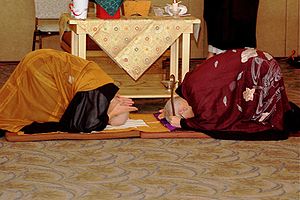
Shiho
Encyclopedia

Soto
Sōtō Zen , or is, with Rinzai and Ōbaku, one of the three most populous sects of Zen in Japanese Buddhism.The Sōtō sect was first established as the Caodong sect during the Tang Dynasty in China by Dongshan Liangjie in the 9th century, which Dōgen Zenji then brought to Japan in the 13th century...
Zen Buddhism wherein which a priest receives full transmission, inheriting the Dharma from his/her master and becoming empowered to transmit the precepts and lineage to others. A shiho ceremony can last anywhere from one to three weeks, with the final ceremony consisting of two specific segments. The first is transmission of the precepts from master to disciple, known as denkai, where the master confirms that the student is actualizing the precepts in his/her day to day life. In this ceremony the student "...become[s] the blood of the Buddha." The second, denpo, is the Dharma transmission
Dharma transmission
Dharma transmission refers to "the manner in which the teaching, or Dharma, is passed from a Zen master to their disciple and heir...
ceremony where the student inherits the Dharma and is empowered to transmit the lineage. In the denpo ceremony, the student becomes an ancestor of the tradition and receives a robe and bowl, among other objects. Also during the denpo ceremony the student receives a Shoshike certificate (which grants the power to perform Jukai
Jukai
The Lay Buddhist ordination refers to the public ordination ceremony wherein a lay student of Zen Buddhism receives certain Buddhist precepts, "a rite in which they publicly avow allegiance to 'The Three Refuges' of Buddhist practice: The Buddha, the dharma and the sangha."-Soto School:In the Sōtō...
) and also the documents known as the "three regalia of transmission": shisho (inheritance certificate), odaiji (a diagram symbolizing the Great Matter) and shoden kechimyaku
Kechimyaku
is a Japanese term for a lineage chart in Zen Buddhism and some other Japanese schools, documenting the "bloodline" of succession of various masters or listing priests in a particular school. In Zen the kechimyaku theoretically links a student to all previous generations back to the Buddha himself...
(bloodline of Dharma transmission). The Sōtō school also confers inka
Inka
, is a term used in Zen Buddhism to denote a high-level of certification, and literally means "the legitimate seal of clearly furnished proof." In ancient times inka usually came in the form of an actual document, but this practice is no longer commonplace...
shōmyō (or inshō) upon students—meaning "'[granting] the seal of approval to a realization of enlightenment'"—and the student must undergo a shiho ceremony to receive Dharma transmission. Following completion of these ceremonies the teacher becomes independent.
External links
- Roshi and His Teachers, Dharma Transmission,and the Rochester Zen Center Lineage Roshi Bodhin Kjolhede discusses lineage and Dharma transmission.
- Coming Down from the Zen Clouds:A Critique of the Current State of American Zen Stuart Lachs criticizes Dharma transmission in Zen
- Ten points to keep in mind about dharma transmission Abbot Muho clarifies the meaning of Shihō in Japanese Sōtō Zen

